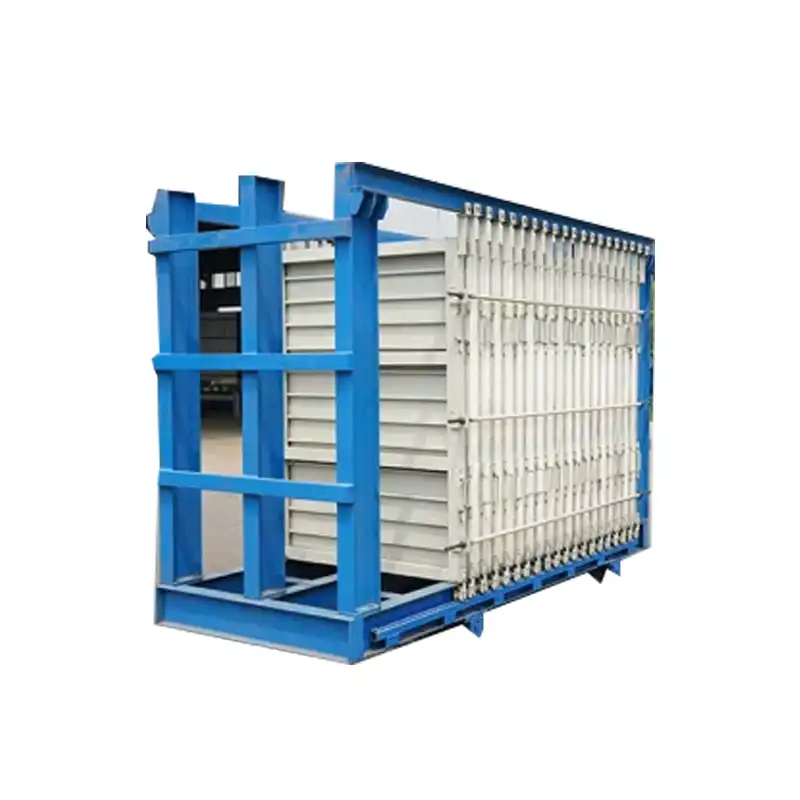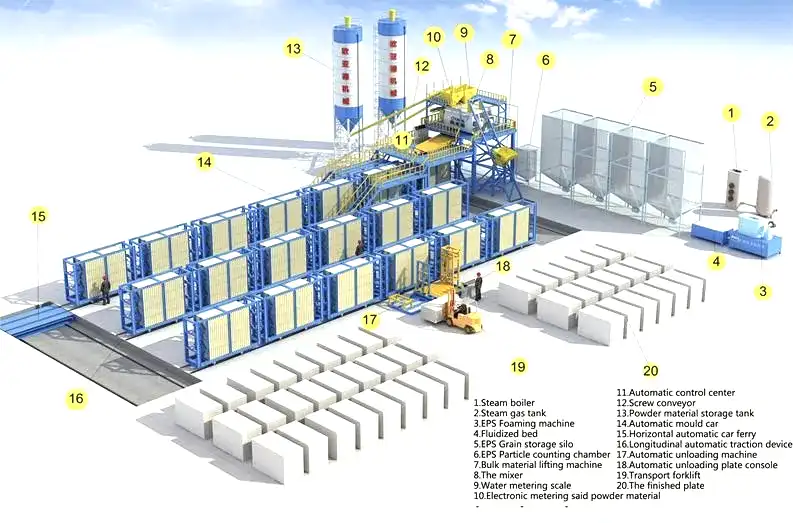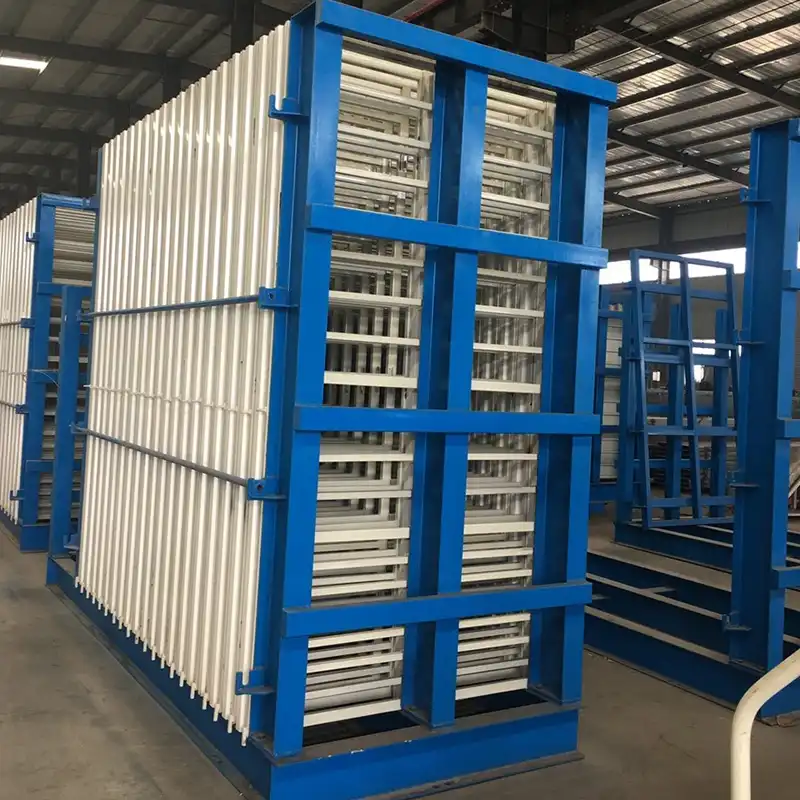
EPS Cement Panel Machine: Build Green, Build Fast
Ready to Build Faster, Stronger, and More Efficiently? Get Your Free EPS Cement Sandwich Panel Machine Quote Today! Get a tailored quote for an EPS Cement Sandwich Panel Machine that meets your specific needs. Our experts will help you find the perfect machine to take your construction business to the next level.
Why Choose EPS Cement Sandwich Panel Machine
Here are some reasons why someone would choose your EPS Cement Sandwich Panel Machine in the following:
Unmatched Efficiency: Our EPS Cement Sandwich Panel Machine boasts industry-leading production speeds, allowing you to manufacture panels faster and fulfill larger orders with ease. This translates to increased profitability and faster project completion times.
Superior Panel Quality: Our innovative machine design ensures consistent panel thickness, density, and surface finish, guaranteeing high-quality construction materials for your clients. This translates to satisfied customers and a strong reputation for your business.
Reduced Production Costs: Through automation and optimized material usage, our machine minimizes waste and streamlines the production process. This translates to lower production costs per panel, maximizing your return on investment.
Durable & Reliable Construction: Built with top-of-the-line components and meticulous engineering, our EPS Cement Sandwich Panel Machine offers exceptional durability and minimal downtime. This translates to long-lasting performance and peace of mind.
Flexible Production Options: Our machine offers the ability to customize panel thickness, length, and even core material within a range, allowing you to cater to diverse project needs. This translates to a wider range of clients and increased market reach.
EPS Cement Sandwich Panel Machine Working Process

The EPS Cement Sandwich Panel Machine automates the production of these lightweight building materials.
Here’s a breakdown of the working process, typically involving several key stages:
1. Raw Material Preparation:
- Cement, fly ash (optional), additives, and water are weighed and measured according to the desired panel properties.
- Screw conveyors or other transport systems deliver these materials to the mixing unit.
2. Mixing:
- A mixer, often a double-shaft design, thoroughly combines the dry ingredients with water to create a uniform cement slurry.
3. EPS Bead Expansion and Shaping:
- EPS beads are pre-expanded through a steaming process.
- The machine might have a dedicated system to precisely distribute and shape the expanded EPS into the desired core configuration within the mold.
4. Molding and Pouring:
- The molding system, often featuring a horizontal or vertical design depending on the machine type, positions the mold for filling.
- The mixed cement slurry is carefully poured into the mold cavity, ensuring it surrounds the shaped EPS core.
5. Curing:
- The filled mold is subjected to controlled pressure and temperature to facilitate the curing process. This stage solidifies the cement mixture and bonds it with the EPS core.
6. Demolding and Finishing:
- Once cured, the machine utilizes a demolding system to safely remove the finished panel from the mold.
- The finished EPS cement sandwich panel may undergo additional finishing processes, such as surface smoothing or edge trimming, depending on the specific application.
Additional Points:
- The entire process can be highly automated, with PLC (Programmable Logic Controller) systems managing various stages for optimal efficiency and consistency.
- Different machine models might have variations in the specific steps or equipment used.
For a deeper understanding about the working process of EPS cement sandwich panel machine, please consider consulting our EPS panel machine expert to give you the best solutions.
FAQs about EPS Cement Sandwich Panel Machine
What is an EPS Cement Sandwich Panel machine?
EPS sandwich panels are composite building materials that consist of a core of expanded polystyrene (EPS) foam sandwiched between two outer layers, typically made of pre-painted steel sheets. This construction creates a lightweight yet structurally rigid panel that offers excellent thermal insulation. The EPS core provides the insulation properties, while the steel sheets provide strength, durability, and weather resistance.
These panels are widely used in the construction of walls, roofs, and ceilings in various applications, including industrial buildings, warehouses, cold storage facilities, and prefabricated homes. Their ease of installation, combined with their thermal efficiency and cost-effectiveness, makes them a popular choice in modern construction. They are known for their ability to provide good thermal insulation, and because of the light weight nature of the EPS core, they are easy to install.
What is EPS Sandwich Panel?
An EPS Cement Sandwich Panel Machine is a piece of equipment used for producing lightweight building panels ideal for walls, roofs, and more.
Components of EPS cement sandwich wall panel machine
- Mixing System: Accurately measures and mixes raw materials like cement, fly ash (sometimes), and water to create a consistent cement slurry.
- Molding System: Holds the mixed material and shapes it around an EPS (expanded polystyrene) core. Molds can be adjustable for different panel thicknesses and sizes.
- EPS Feeding System: Dispenses and positions EPS beads precisely within the mold cavity.
- Curing System: Provides controlled pressure and temperature for the panels to solidify properly.
- Demolding System: Safely removes the finished panels from the mold.
What are EPS Cement Sandwich Panels?
EPS Cement Sandwich Panels are lightweight building materials with an EPS (expanded polystyrene) core encased between two layers of cement facings. They offer advantages like good insulation, fire resistance, and ease of construction.
What are the benefits of using an EPS Cement Sandwich Panel Machine?
Faster production compared to manual methods.
Consistent panel quality and reduced waste.
Lower production costs per panel.
Ability to customize panels for various projects.
What are the different types of EPS Cement Sandwich Panel Machines?
There are generally two main types: horizontal EPS cement sandwich panel machine and vertical.
Horizontal machines offer higher automation and require less floor space, while vertical machines can have a higher output but require more manpower.
EPS Cement Sandwich Panel Manufacturing Process
The manufacturing process of EPS cement sandwich panels involves several key stages, each contributing to the panel’s structural integrity and thermal performance.
This process combines the insulating properties of EPS with the strength and durability of cementitious materials, creating a versatile building component.
Step 1: Preparing the EPS Core and Cementitious Layers
The process begins with the preparation of the expanded polystyrene (EPS) core. This involves cutting or shaping the EPS foam to the required dimensions, ensuring a uniform thickness and surface. Simultaneously, the cementitious layers are prepared.
These layers typically consist of a mixture of cement, sand, and additives, which are blended to achieve the desired consistency and strength. The preparation of these materials is crucial for ensuring the panel’s overall quality and performance.
The cementitious mixture is then applied to the outer surfaces of the EPS core. This can be done through spraying, rolling, or pressing, depending on the manufacturing setup. The application process is carefully controlled to ensure a uniform layer thickness and consistent adhesion to the EPS core. The quality of the cementitious layers directly impacts the panel’s structural strength, fire resistance, and weather resistance.
Step 2: Bonding and Pressing the Layers
After the cementitious layers are applied, the panel is subjected to a bonding and pressing process. This involves applying pressure to the panel to ensure a strong bond between the EPS core and the cementitious layers. The pressure is typically applied using a hydraulic press or a continuous lamination line, which ensures uniform compression and adhesion.
The bonding process may also involve the application of heat or adhesives to enhance the bond between the EPS core and the cementitious layers. The specific bonding method depends on the materials used and the desired panel properties. The goal is to create a strong, durable bond that can withstand the stresses and environmental conditions the panel will encounter in its application.
Step 3: Curing and Drying the Panels
Once the layers are bonded, the panels undergo a curing and drying process. This stage is crucial for ensuring the cementitious layers achieve their full strength and durability. The panels are typically placed in a curing chamber or allowed to dry under controlled environmental conditions, such as specific temperature and humidity levels.
The curing process allows the cementitious materials to hydrate and harden, forming a solid, durable outer layer. The duration of the curing and drying process depends on the specific cementitious mixture used and the desired panel properties. Proper curing is essential for preventing cracking, warping, and other defects in the finished panels.
Step 4: Quality Control and Finishing
After curing and drying, the panels undergo a thorough quality control inspection. This involves checking for dimensional accuracy, surface finish, and structural integrity. Any panels that fail to meet the required specifications are rejected or reworked.
The finishing process may include cutting the panels to the desired dimensions, applying surface treatments, or adding edge details. These finishing steps enhance the panel’s appearance, performance, and ease of installation. The finished panels are then packaged and prepared for shipment to construction sites or distribution centers.

